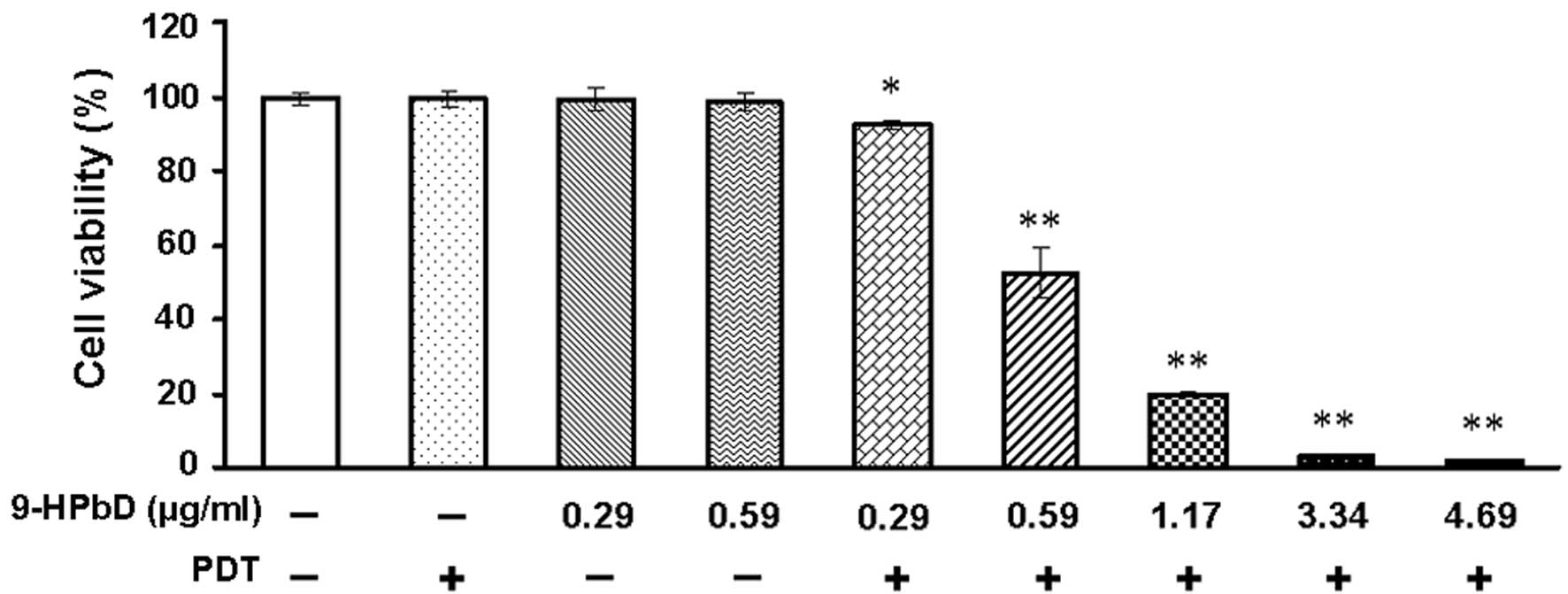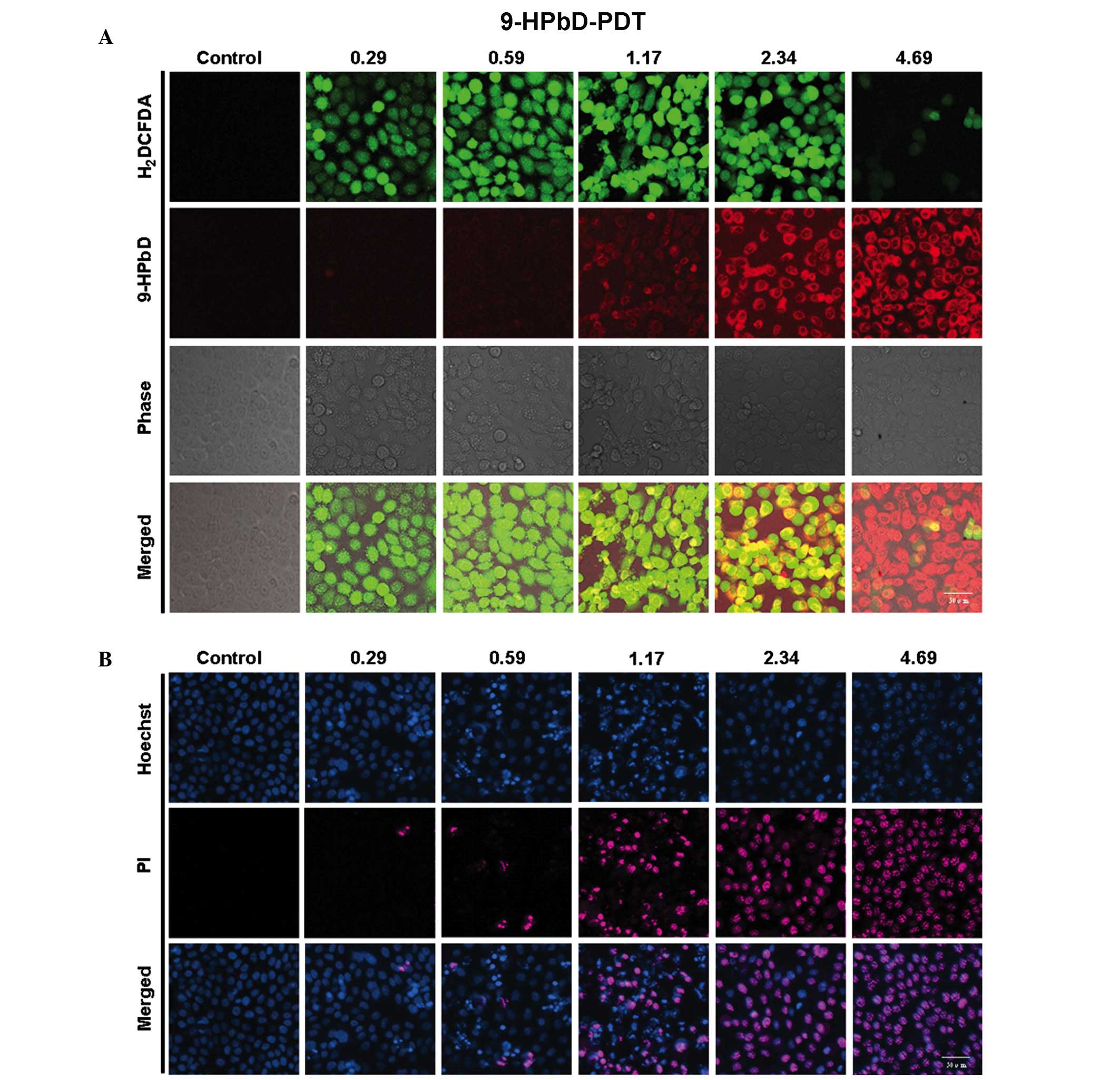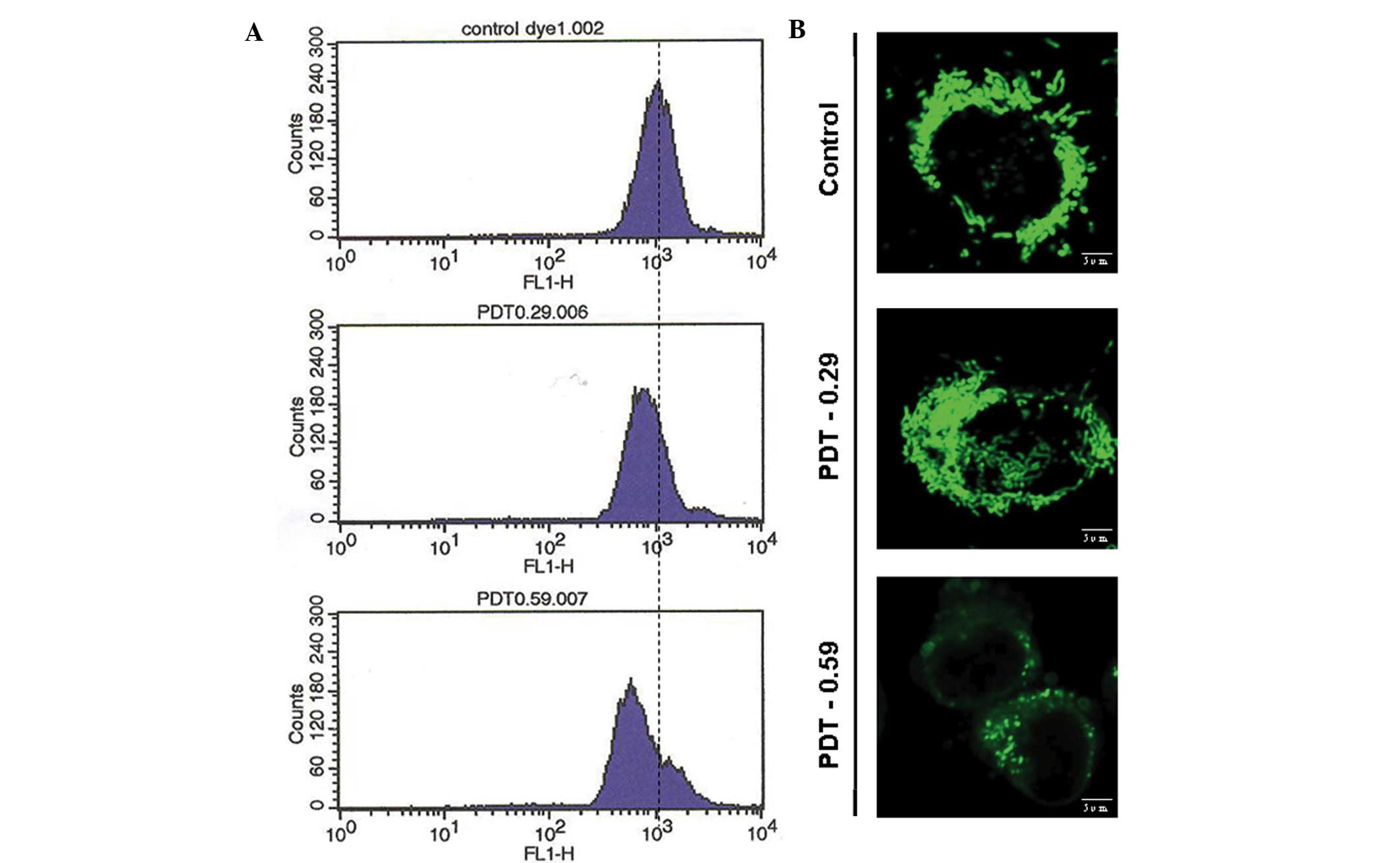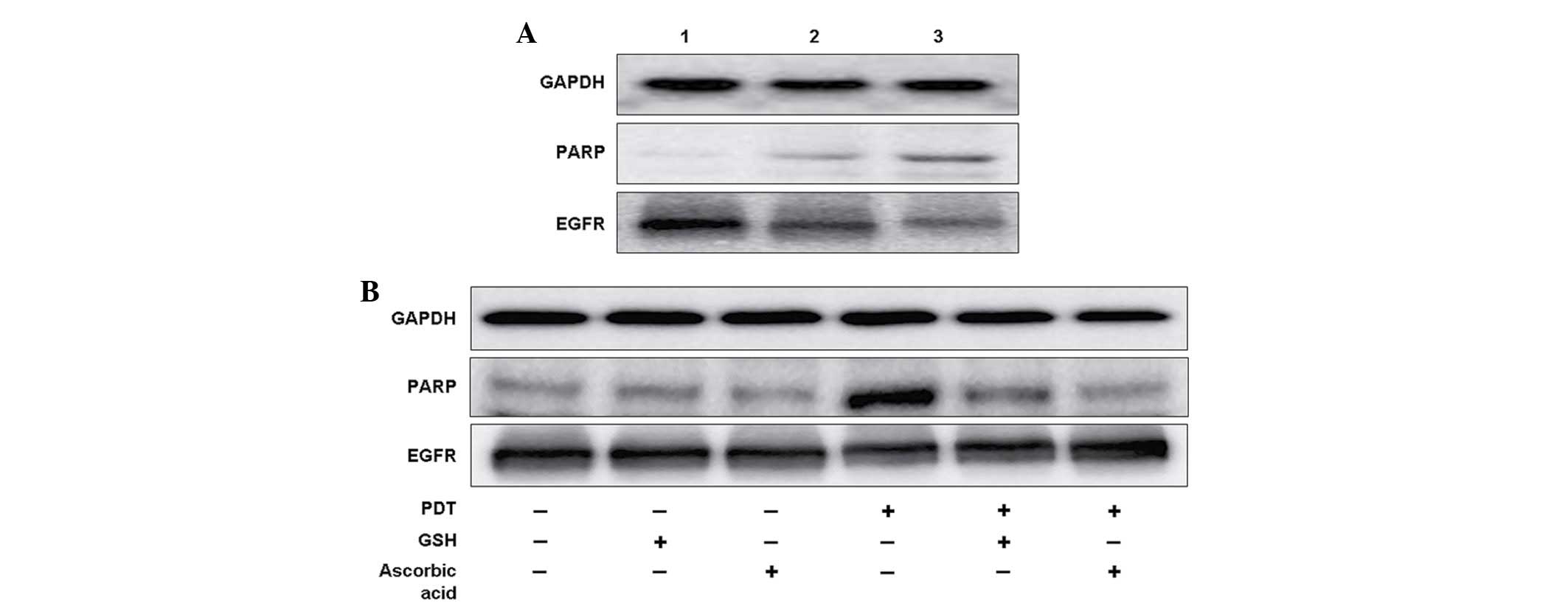|
1
|
Buytaert E, Dewaele M and Agostinis P:
Molecular effectors of multiple cell death pathways initiated by
photodynamic therapy. Biochim Biophys Acta. 1776:86–107.
2007.PubMed/NCBI
|
|
2
|
Agostinis P, Berg K, Cengel KA, Foster TH,
Girotti AW, Gollnick SO, Hahn SM, Hamblin MR, Juzeniene A, Kessel
D, et al: Photodynamic therapy of cancer: An update. CA Cancer J
Clin. 61:250–281. 2011. View Article : Google Scholar : PubMed/NCBI
|
|
3
|
Choi SE, Sohn S, Cho JW, Shin EA, Song PS
and Kang Y: 9-Hydroxypheophorbide α-induced apoptotic death of
MCF-7 breast cancer cells is mediated by c-Jun N-terminal kinase
activation. J Photochem Photobiol B. 73:101–107. 2004. View Article : Google Scholar : PubMed/NCBI
|
|
4
|
He P, Ahn JC, Shin JI, Hwang HJ, Kang JW,
Lee SJ and Chung PS: Enhanced apoptotic effect of combined modality
of 9-hydroxypheophorbide alpha-mediated photodynamic therapy and
carboplatin on AMC-HN-3 human head and neck cancer cells. Oncol
Rep. 21:329–334. 2009.PubMed/NCBI
|
|
5
|
Kim SY, Chu KC, Lee HR, Lee KS and Carey
TE: Establishment and characterization of nine new head and neck
cancer cell lines. Acta Otolaryngol. 117:775–784. 1997. View Article : Google Scholar : PubMed/NCBI
|
|
6
|
Chung PS, He P, Shin JI, Hwang HJ, Lee SJ
and Ahn JC: Photodynamic therapy with 9-hydroxypheophorbide alpha
on AMC-HN-3 human head and neck cancer cells: Induction of
apoptosis via photoactivation of mitochondria and endoplasmic
reticulum. Cancer Biol Ther. 8:1343–1351. 2009. View Article : Google Scholar : PubMed/NCBI
|
|
7
|
Moan J and Berg K: Photochemotherapy of
cancer: Experimental research. Photochem Photobiol. 55:931–948.
1992. View Article : Google Scholar : PubMed/NCBI
|
|
8
|
Moan J and Berg K: The photodegradation of
porphyrins in cells can be used to estimate the lifetime of singlet
oxygen. Photochem Photobiol. 53:549–553. 1991. View Article : Google Scholar : PubMed/NCBI
|
|
9
|
Oleinick NL, Morris RL and Belichenko I:
The role of apoptosis in response to photodynamic therapy: What,
where, why, and how. Photochem Photobiol Sci. 1:1–21. 2002.
View Article : Google Scholar : PubMed/NCBI
|
|
10
|
Biel MA: Photodynamic therapy treatment of
early oral and laryngeal cancers. Photochem Photobiol.
83:1063–1068. 2007. View Article : Google Scholar : PubMed/NCBI
|
|
11
|
Boulares AH, Yakovlev AG, Ivanova V,
Stoica BA, Wang G, Iyer S and Smulson M: Role of poly (ADP-ribose)
polymerase (PARP) cleavage in apoptosis: Caspase 3-resistant PARP
mutant increases rates of apoptosis in transfected cells. J Biol
Chem. 274:22932–22940. 1999. View Article : Google Scholar : PubMed/NCBI
|
|
12
|
Tewari M, Quan LT, O'Rourke K, Desnoyers
S, Zeng Z, Beidler DR, Poirier GG, Salvesen GS and Dixit VM:
Yama/CPP32 beta, a mammalian homolog of CED-3, is a
CrmA-inhibitable protease that cleaves the death substrate
poly(ADP-ribose) polymerase. Cell. 81:801–809. 1995. View Article : Google Scholar : PubMed/NCBI
|
|
13
|
Verma S, Watt GM, Mai Z and Hasan T:
Strategies for enhanced photodynamic therapy effects. Photochem
Photobiol. 83:996–1005. 2007. View Article : Google Scholar : PubMed/NCBI
|
|
14
|
Fang X, Wu P, Li J, Qi L, Tang Y, Jiang W
and Zhao S: Combination of apoptin with photodynamic therapy
induces nasopharyngeal carcinoma cell death in vitro and in vivo.
Oncol Rep. 28:2077–2082. 2012.PubMed/NCBI
|
|
15
|
Liu JX, Zhang JH, Li HH, Lai FJ, Chen KJ,
Chen H, Luo J, Guo HC, Wang ZH and Lin SZ: Emodin induces Panc-1
cell apoptosis via declining the mitochondrial membrane potential.
Oncol Rep. 28:1991–1996. 2012.PubMed/NCBI
|
|
16
|
Wang CZ, Calway TD, Wen XD, Smith J, Yu C,
Wang Y, Mehendale SR and Yuan CS: Hydrophobic flavonoids from
Scutellaria baicalensis induce colorectal cancer cell
apoptosis through a mitochondrial-mediated pathway. Int J Oncol.
42:1018–1026. 2013.PubMed/NCBI
|
|
17
|
Lai JC, Lo PC, Ng DK, Ko WH, Leung SC,
Fung KP and Fong WP: BAM-SiPc, a novel agent for photodynamic
therapy, induces apoptosis in human hepatocarcinoma HepG2 cells by
a direct mitochondrial action. Cancer Biol Ther. 5:413–418. 2006.
View Article : Google Scholar : PubMed/NCBI
|
|
18
|
Granville DJ, Shaw JR, Leong S, Carthy CM,
Margaron P, Hunt DW and McManus BM: Release of cytochrome c, Bax
migration, Bid cleavage, and activation of caspases 2, 3, 6, 7, 8
and 9 during endothelial cell apoptosis. Am J Pathol.
155:1021–1025. 1999. View Article : Google Scholar : PubMed/NCBI
|
|
19
|
Kalyankrishna S and Grandis JR: Epidermal
growth factor receptor biology in head and neck cancer. J Clin
Oncol. 24:2666–2672. 2006. View Article : Google Scholar : PubMed/NCBI
|
|
20
|
Woodburn JR: The epidermal growth factor
receptor and its inhibition in cancer therapy. Pharmocol Ther.
82:241–250. 1999. View Article : Google Scholar
|
|
21
|
Kim SG, Hong JW, Boo SH, Kim MG, Lee KD,
Ahn JC, Hwang HJ, Shin JI, Lee SJ, Oh JK and Chung PS: Combination
treatment of Cetuximab and photodynamic therapy in SNU-1041
squamous cancer cell line. Oncol Rep. 22:701–708. 2009.PubMed/NCBI
|
|
22
|
Koon HK, Chan PS, Wong RN, Wu ZG, Lung ML,
Chang CK and Mak NK: Targeted inhibition of the EGFR pathways
enhances Zn-BC-AM PDT-induced apoptosis in well-differentiated
nasopharyngeal carcinoma cells. J Cell Biochem. 108:1356–1363.
2009. View Article : Google Scholar : PubMed/NCBI
|
|
23
|
Martínez-Carpio PA and Trelles MA: The
role of epidermal growth factor receptor in photodynamic therapy: A
review of the literature and proposal for future investigation.
Lasers Med Sci. 25:767–771. 2010. View Article : Google Scholar : PubMed/NCBI
|














